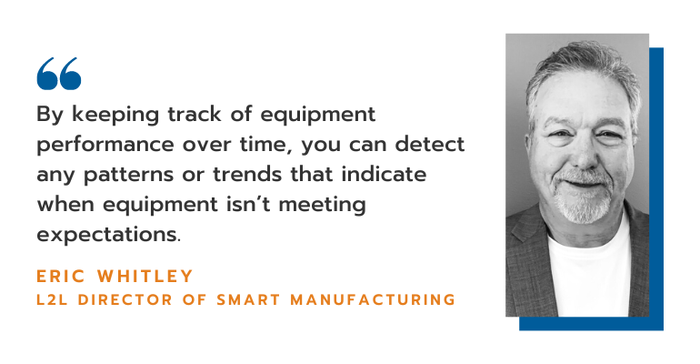A manufacturing expert explains the benefits of proactive equipment maintenance in medical device manufacturing.

Proactive equipment maintenance is crucial in the medical equipment manufacturing industry because it ensures the safety of the patients relying on medical products. Regularly inspecting and servicing your medical manufacturing equipment helps identify potential issues before they become major problems, preventing costly repairs, downtime, and even product recalls.
However, the quality of your products can be compromised if you’re not properly maintaining your equipment.
In this article, we explore how proactive equipment maintenance enables your facility to produce medical products that meet the highest standards, reduces downtime, enhances safety, and increases your equipment’s lifespan.
Proactive equipment maintenance reduces downtime
At manufacturing facilities, downtime is a huge problem, mainly due to decreased production volume. However, there’s a simple solution.
Proactive equipment maintenance reduces downtime by identifying potential issues before they escalate and lead to costly repairs or replacements. For example, you can identify worn or damaged parts in a wave soldering machine that is used to solder integrated circuit (IC) chips on the printed circuit board of an ultrasound machine. Replacing worn parts during proactive maintenance inspection ensures the machine won’t break down while it’s soldering the printed circuit boards.
A proactive maintenance plan can be developed with computerized maintenance management system software. You can set up regular inspections and servicing schedules based on the usage and performance of all the manufacturing equipment at the facility. This will increase their availability for the production process.
Proactive maintenance enhances equipment performance

Manufacturing equipment that is not functioning well can affect the quality of medical products negatively. To avoid this, it is important to regularly maintain the equipment and identify any issues that may be affecting its accuracy, precision, or reliability.
Regularly checking and taking care of equipment helps you spot any issues or parts that need replacing. Make sure the equipment is calibrated correctly and working within acceptable limits. This improves accuracy and precision, which means you can produce better quality medical products.
Taking a proactive approach to maintenance can help identify any underperforming equipment. By keeping track of equipment performance over time, you can detect any patterns or trends that indicate when equipment isn’t meeting expectations.
For example, pulse oxygen meters require testing and calibration before shipping out. If the machines used for testing are not calibrated properly, the oxygen meters can produce inaccurate results when used in healthcare facilities. This could have serious repercussions for patients, providers, and manufacturers.
Proactive equipment maintenance increases efficiency
Conducting regular equipment maintenance and inspections helps your equipment operate at the highest level. This prevents equipment breakdowns by identifying equipment or components that cause unplanned interruptions.
Optimizing processes through proactive maintenance also helps you identify opportunities for enhancing efficiency. This can include recognizing underutilized equipment or procedures that could be automated.
In the production of sphygmomanometers, for instance, it’s necessary to test and calibrate them using a pressure testing machine. Automated pressure testing machines help you efficiently produce large quantities of these devices. By automating this process, you can significantly reduce the time and effort needed to meet product quality standards.
Efficient equipment requires less maintenance, consumes fewer resources, and generates fewer defects or errors, resulting in lower operational costs and greater profitability.
Proactive equipment maintenance enhances safety
Ensuring the safety of your products is of utmost importance. Proactive equipment maintenance can identify and address potential safety hazards, such as malfunctioning machines. You can ensure that all safety mechanisms are functioning, such as emergency stops, safety interlocks and safety sensors. You can also verify that all safety labels and warning signs are in place and legible.
Proactive maintenance can help you prevent safety incidents by identifying and addressing potential safety hazards, such as overheating equipment, before they occur.
Proactive maintenance makes products safer for patients, too. For example, high-speed compressors that fill oxygen tanks can overheat and fail if not regularly serviced. To prevent this, you can use proactive maintenance strategies to make sure the compressors work correctly and consistently fill oxygen bottles at the correct pressure.
Improving safety measures doesn’t only keep your employees safe — it also protects your company from potential legal and reputational problems. Accidents and injuries can lead to legal violations and lawsuits that can harm your company's reputation.
Proactive maintenance improves product consistency
To maintain customer loyalty and a good reputation, you need to produce high-quality products consistently. One way to meet your quality standards is proactively maintaining equipment to address any issues that impact product quality.
Make sure your equipment is working smoothly and producing the same quality results every time. If you see an uptick in scrap, it usually means your machine is malfunctioning and needs maintenance. Addressing these issues early will save you both time and money.
For example, hospitals purchase surgical instruments in bulk. These instruments, such as scalpels, saws, blades, scissors, and forceps, must meet the hospitals’ precise specifications. The medical equipment factory produces and meticulously tests each instrument to ensure it meets the buyer’s standards.
To meet these standards, you’ll most likely use automated machines to perform testing and calibration on your equipment. It's important to regularly check and calibrate these machines to maintain their accuracy. Doing so guarantees that the produced instruments are defect-free before they reach hospitals.
Proactive maintenance increases equipment lifespan
To make the most of your investment and avoid expensive repairs and replacements, it's important to keep your equipment in good condition for as long as possible. Regular maintenance can help you achieve that and improve the quality of your medical products.
For example, ventilators are essential life support equipment used for critically ill patients. Preventive maintenance can identify and address any defects, malfunctions, and stress that may cause premature wear and tear on machines that produce ventilator components, ultimately extending the equipment’s lifespan.
Replacing or repairing equipment can be costly and cause disruptions, resulting in lost revenue for manufacturing facilities. However, extending equipment lifespan can lead to long-term cost savings.
As a medical equipment manufacturer, it's crucial to prioritize equipment quality. Proactive maintenance can help improve performance, minimize the chances of malfunctions, and save you money in the long run. By demonstrating a dedication to safety and quality, you also establish a reputation for excellence, enhance customer satisfaction, foster loyalty, and ultimately drive growth and profitability for your business.
Eric Whitley is the director of smart manufacturing at L2L, and a veteran thought leader in the manufacturing industry.
About the Author(s)
You May Also Like




